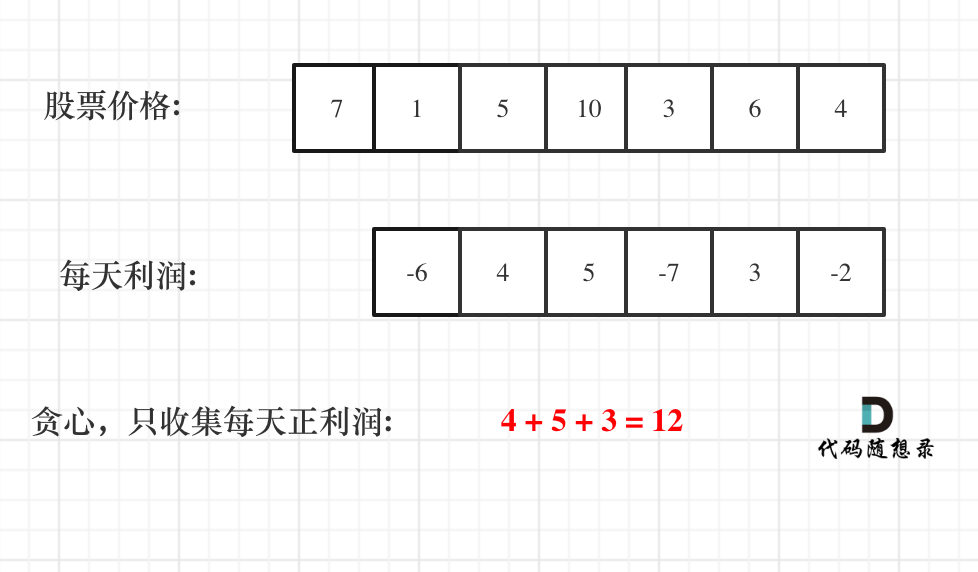0122.买卖股票的最佳时机II
参与本项目,贡献其他语言版本的代码,拥抱开源,让更多学习算法的小伙伴们收益!
# 122.买卖股票的最佳时机 II [力扣题目链接](https://leetcode.cn/problems/best-time-to-buy-and-sell-stock-ii/) 给定一个数组,它的第 i 个元素是一支给定股票第 i 天的价格。 设计一个算法来计算你所能获取的最大利润。你可以尽可能地完成更多的交易(多次买卖一支股票)。 注意:你不能同时参与多笔交易(你必须在再次购买前出售掉之前的股票)。 示例 1: - 输入: [7,1,5,3,6,4] - 输出: 7 - 解释: 在第 2 天(股票价格 = 1)的时候买入,在第 3 天(股票价格 = 5)的时候卖出, 这笔交易所能获得利润 = 5-1 = 4。随后,在第 4 天(股票价格 = 3)的时候买入,在第 5 天(股票价格 = 6)的时候卖出, 这笔交易所能获得利润 = 6-3 = 3 。 示例 2: - 输入: [1,2,3,4,5] - 输出: 4 - 解释: 在第 1 天(股票价格 = 1)的时候买入,在第 5 天 (股票价格 = 5)的时候卖出, 这笔交易所能获得利润 = 5-1 = 4 。注意你不能在第 1 天和第 2 天接连购买股票,之后再将它们卖出。因为这样属于同时参与了多笔交易,你必须在再次购买前出售掉之前的股票。 示例 3: - 输入: [7,6,4,3,1] - 输出: 0 - 解释: 在这种情况下, 没有交易完成, 所以最大利润为 0。 提示: - 1 <= prices.length <= 3 \* 10 ^ 4 - 0 <= prices[i] <= 10 ^ 4 ## 算法公开课 **[《代码随想录》算法视频公开课](https://programmercarl.com/other/gongkaike.html):[贪心算法也能解决股票问题!LeetCode:122.买卖股票最佳时机 II](https://www.bilibili.com/video/BV1ev4y1C7na),相信结合视频在看本篇题解,更有助于大家对本题的理解**。 ## 思路 本题首先要清楚两点: - 只有一只股票! - 当前只有买股票或者卖股票的操作 想获得利润至少要两天为一个交易单元。 ### 贪心算法 这道题目可能我们只会想,选一个低的买入,再选个高的卖,再选一个低的买入.....循环反复。 **如果想到其实最终利润是可以分解的,那么本题就很容易了!** 如何分解呢? 假如第 0 天买入,第 3 天卖出,那么利润为:prices[3] - prices[0]。 相当于(prices[3] - prices[2]) + (prices[2] - prices[1]) + (prices[1] - prices[0])。 **此时就是把利润分解为每天为单位的维度,而不是从 0 天到第 3 天整体去考虑!** 那么根据 prices 可以得到每天的利润序列:(prices[i] - prices[i - 1]).....(prices[1] - prices[0])。 如图:  一些同学陷入:第一天怎么就没有利润呢,第一天到底算不算的困惑中。 第一天当然没有利润,至少要第二天才会有利润,所以利润的序列比股票序列少一天! 从图中可以发现,其实我们需要收集每天的正利润就可以,**收集正利润的区间,就是股票买卖的区间,而我们只需要关注最终利润,不需要记录区间**。 那么只收集正利润就是贪心所贪的地方! **局部最优:收集每天的正利润,全局最优:求得最大利润**。 局部最优可以推出全局最优,找不出反例,试一试贪心! 对应 C++代码如下:class Solution {
public:
int maxProfit(vector<int>& prices) {
int result = 0;
for (int i = 1; i < prices.size(); i++) {
result += max(prices[i] - prices[i - 1], 0);
}
return result;
}
};
class Solution {
public:
int maxProfit(vector<int>& prices) {
// dp[i][1]第i天持有的最多现金
// dp[i][0]第i天持有股票后的最多现金
int n = prices.size();
vector<vector<int>> dp(n, vector<int>(2, 0));
dp[0][0] -= prices[0]; // 持股票
for (int i = 1; i < n; i++) {
// 第i天持股票所剩最多现金 = max(第i-1天持股票所剩现金, 第i-1天持现金-买第i天的股票)
dp[i][0] = max(dp[i - 1][0], dp[i - 1][1] - prices[i]);
// 第i天持有最多现金 = max(第i-1天持有的最多现金,第i-1天持有股票的最多现金+第i天卖出股票)
dp[i][1] = max(dp[i - 1][1], dp[i - 1][0] + prices[i]);
}
return max(dp[n - 1][0], dp[n - 1][1]);
}
};
// 贪心思路
class Solution {
public int maxProfit(int[] prices) {
int result = 0;
for (int i = 1; i < prices.length; i++) {
result += Math.max(prices[i] - prices[i - 1], 0);
}
return result;
}
}
class Solution { // 动态规划
public int maxProfit(int[] prices) {
// [天数][是否持有股票]
int[][] dp = new int[prices.length][2];
// base case
dp[0][0] = 0;
dp[0][1] = -prices[0];
for (int i = 1; i < prices.length; i++) {
// dp公式
dp[i][0] = Math.max(dp[i - 1][0], dp[i - 1][1] + prices[i]);
dp[i][1] = Math.max(dp[i - 1][1], dp[i - 1][0] - prices[i]);
}
return dp[prices.length - 1][0];
}
}
class Solution:
def maxProfit(self, prices: List[int]) -> int:
result = 0
for i in range(1, len(prices)):
result += max(prices[i] - prices[i - 1], 0)
return result
class Solution:
def maxProfit(self, prices: List[int]) -> int:
length = len(prices)
dp = [[0] * 2 for _ in range(length)]
dp[0][0] = -prices[0]
dp[0][1] = 0
for i in range(1, length):
dp[i][0] = max(dp[i-1][0], dp[i-1][1] - prices[i]) #注意这里是和121. 买卖股票的最佳时机唯一不同的地方
dp[i][1] = max(dp[i-1][1], dp[i-1][0] + prices[i])
return dp[-1][1]
func maxProfit(prices []int) int {
var sum int
for i := 1; i < len(prices); i++ {
// 累加每次大于0的交易
if prices[i] - prices[i-1] > 0 {
sum += prices[i] - prices[i-1]
}
}
return sum
}
func maxProfit(prices []int) int {
dp := make([][]int, len(prices))
for i := 0; i < len(dp); i++ {
dp[i] = make([]int, 2)
}
// dp[i][0]表示在状态i不持有股票的现金,dp[i][1]为持有股票的现金
dp[0][0], dp[0][1] = 0, -prices[0]
for i := 1; i < len(prices); i++ {
dp[i][0] = max(dp[i-1][0], dp[i-1][1] + prices[i])
dp[i][1] = max(dp[i-1][0] - prices[i], dp[i-1][1])
}
return dp[len(prices)-1][0]
}
func max(a, b int) int {
if a > b {
return a
}
return b
}
var maxProfit = function(prices) {
let result = 0
for(let i = 1; i < prices.length; i++) {
result += Math.max(prices[i] - prices[i - 1], 0)
}
return result
};
const maxProfit = (prices) => {
let dp = Array.from(Array(prices.length), () => Array(2).fill(0));
// dp[i][0] 表示第i天持有股票所得现金。
// dp[i][1] 表示第i天不持有股票所得最多现金
dp[0][0] = 0 - prices[0];
dp[0][1] = 0;
for (let i = 1; i < prices.length; i++) {
// 如果第i天持有股票即dp[i][0], 那么可以由两个状态推出来
// 第i-1天就持有股票,那么就保持现状,所得现金就是昨天持有股票的所得现金 即:dp[i - 1][0]
// 第i天买入股票,所得现金就是昨天不持有股票的所得现金减去 今天的股票价格 即:dp[i - 1][1] - prices[i]
dp[i][0] = Math.max(dp[i - 1][0], dp[i - 1][1] - prices[i]);
// 在来看看如果第i天不持有股票即dp[i][1]的情况, 依然可以由两个状态推出来
// 第i-1天就不持有股票,那么就保持现状,所得现金就是昨天不持有股票的所得现金 即:dp[i - 1][1]
// 第i天卖出股票,所得现金就是按照今天股票佳价格卖出后所得现金即:prices[i] + dp[i - 1][0]
dp[i][1] = Math.max(dp[i - 1][1], dp[i - 1][0] + prices[i]);
}
return dp[prices.length - 1][1];
};
function maxProfit(prices: number[]): number {
let resProfit: number = 0;
for (let i = 1, length = prices.length; i < length; i++) {
resProfit += Math.max(prices[i] - prices[i - 1], 0);
}
return resProfit;
}
function maxProfit(prices: number[]): number {
const dp = Array(prices.length)
.fill(0)
.map(() => Array(2).fill(0))
dp[0][0] = -prices[0]
for (let i = 1; i < prices.length; i++) {
dp[i][0] = Math.max(dp[i - 1][0], dp[i - 1][1] - prices[i])
dp[i][1] = Math.max(dp[i - 1][1], dp[i - 1][0] + prices[i])
}
return dp[prices.length - 1][1]
}
impl Solution {
pub fn max_profit(prices: Vec<i32>) -> i32 {
let mut result = 0;
for i in 1..prices.len() {
result += (prices[i] - prices[i - 1]).max(0);
}
result
}
}
impl Solution {
pub fn max_profit(prices: Vec<i32>) -> i32 {
let mut dp = vec![vec![0; 2]; prices.len()];
dp[0][0] = -prices[0];
for i in 1..prices.len() {
dp[i][0] = dp[i - 1][0].max(dp[i - 1][1] - prices[i]);
dp[i][1] = dp[i - 1][1].max(dp[i - 1][0] + prices[i]);
}
dp[prices.len() - 1][1]
}
}
int maxProfit(int* prices, int pricesSize){
int result = 0;
int i;
//从第二个元素开始遍历数组,与之前的元素进行比较
for(i = 1; i < pricesSize; ++i) {
//若该元素比前面元素大,则说明有利润。代表买入
if(prices[i] > prices[i-1])
result+= prices[i]-prices[i-1];
}
return result;
}
#define max(a, b) (((a) > (b)) ? (a) : (b))
int maxProfit(int* prices, int pricesSize){
int dp[pricesSize][2];
dp[0][0] = 0 - prices[0];
dp[0][1] = 0;
int i;
for(i = 1; i < pricesSize; ++i) {
// dp[i][0]为i-1天持股的钱数/在第i天用i-1天的钱买入的最大值。
// 若i-1天持股,且第i天买入股票比i-1天持股时更亏,说明应在i-1天时持股
dp[i][0] = max(dp[i-1][0], dp[i-1][1] - prices[i]);
//dp[i][1]为i-1天不持股钱数/在第i天卖出所持股票dp[i-1][0] + prices[i]的最大值
dp[i][1] = max(dp[i-1][1], dp[i-1][0] + prices[i]);
}
// 返回在最后一天不持股时的钱数(将股票卖出后钱最大化)
return dp[pricesSize - 1][1];
}

